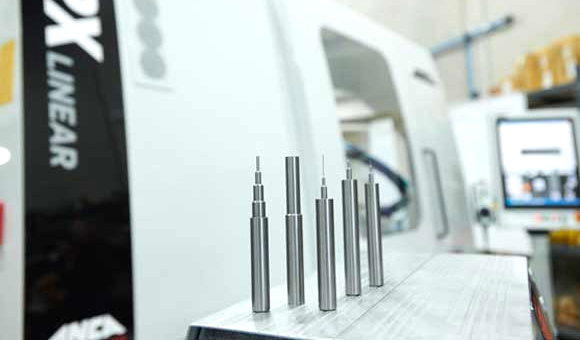Despite its advantages, 3D printing has had a difficult time breaking into the manufacturing mainstream. That trend has shifted in the past few years, with 40% of manufacturers today adding these technologies to their workflows. Similarly, 72% now agree that 3D printing will become a staple in manufacturing departments. A new hybrid cutting tool manufacturing platform from ANCA and CSIRO highlights why this shift is taking place.
A Collaboration Three Years in the Making
ANCA, an Australian machine tools manufacturer, and CSIRO, Australia’s national science agency, first collaborated in 2019 through a six-month pilot project. Since then, the two have been working together to produce a hybrid of additive and subtractive manufacturing methods for cutting tools.
The next phase of the collaboration, a nine-month, $928,000 program aims to refine the production technologies in the process. When finished, the two organizations will create a single platform to handle the current multistage method of manufacturing tungsten cutting tools. This equipment must flow through mold pressing, sintering, blazing and grinding, but the hybrid platform could perform it all in just a few steps.
ANCA and CSIRO expect the unified process to lower production costs and bring tungsten cutting tool production back to Australia. If it works, these advancements could disrupt manufacturing processes worldwide.
The Need for New Methods
This technology arrives at the right time in the manufacturing industry. Current multistage processes for creating tungsten carbide cutting tools are inefficient, expensive and often wasteful.
Roughly 20% of every dollar spent on the manufacturing industry goes to waste. It arises from many factors, but inefficient material processing practices comprise a considerable portion. Subtractive manufacturing can remove more material than it uses, and creating the tools needed for this machining is similarly wasteful, resulting in a highly inefficient cycle.
Traditional approaches to cutting tool production are also slow. Moving through multiple stages wastes time and requires more workers, resources which are currently in limited supply. These processes must change if manufacturers hope to become more economically and environmentally sustainable. Hybrid 3D printing solutions like that developed by ANCA and CSIRO may be the answer.
The Hybrid Advantage
ANCA and CSIRO’s hybrid offering provides several advantages over traditional methods. It allows significant time and personnel savings since it combines the once four-step process into a single platform. Producers of tungsten cutting tools will reduce their operating expenses, and high-performing products will become more affordable to end-users.
Integrating 3D printing into the process brings further improvements. Producing high-performance tools requires careful material calculations, leaving a slim margin for error. Additive manufacturing’s precision can ensure manufacturers stay within these small margins, reducing defects and waste.
3D printing processes are also generally faster and less energy-intensive than subtractive manufacturing, further lowering costs and increasing efficiency. Offering a hybrid platform lets companies experience these benefits without the typically high costs of using 3D printing for the entire process.
The hybrid approach could also help manufacturers overcome common 3D printing adoption barriers. A lack of expertise and uncertainty over quality are some of the largest 3D printing obstacles, with 41.3% and 33.1% of manufacturers citing them, respectively. Combining these technologies with more familiar processes can help ease these concerns.
A Larger Movement in 3D Printing
This project from ANCA and CSIRO is part of a larger trend in 3D printing. Tool manufacturer Star SU Neher embraced 3D printing in 2021 for large cutting tools. Using additive manufacturing for these products allowed the company to use lighter equipment to produce bigger tools, improving machine longevity.
Similarly, cutting tool producer Kennametal produces tungsten carbide materials for 3D printers. This allows manufacturers to create parts and equipment in the metal through additive manufacturing, reducing the high energy and time requirements.
The need for more affordable, sustainable and faster processes will also rise as pressures around the manufacturing industry increase. This, in turn, will lead to more companies looking for 3D printing solutions. Projects like those from ANCA and CSIRO will meet that need, paving the way for a new generation in manufacturing.
Subscribe to Our Email Newsletter
Stay up-to-date on all the latest news from the 3D printing industry and receive information and offers from third party vendors.
You May Also Like
Gorilla Sports GE’s First 3D Printed Titanium Cast
How do you help a gorilla with a broken arm? Sounds like the start of a bad joke a zookeeper might tell, but it’s an actual dilemma recently faced by...
Nylon 3D Printed Parts Made More Functional with Coatings & Colors
Parts 3D printed from polyamide (PA, Nylon) 12 using powder bed fusion (PBF) are a mainstay in the additive manufacturing (AM) industry. While post-finishing processes have improved the porosity of...
$25M to Back Sintavia’s Largest Expansion of Metal 3D Printing Capacity Since 2019
Sintavia, the digital manufacturing company specializing in mission-critical parts for strategic sectors, announced a $25 million investment to increase its production capacity, the largest expansion to its operations since 2019....
Velo3D Initiates Public Offering in a Bid to Strengthen Financial Foundations and Drive Future Growth
Velo3D (NYSE: VLD) has been among a number of publicly traded 3D printing firms that have attempted to weather the current macroeconomic climate. After posting a challenging financial report for 2023,...
































